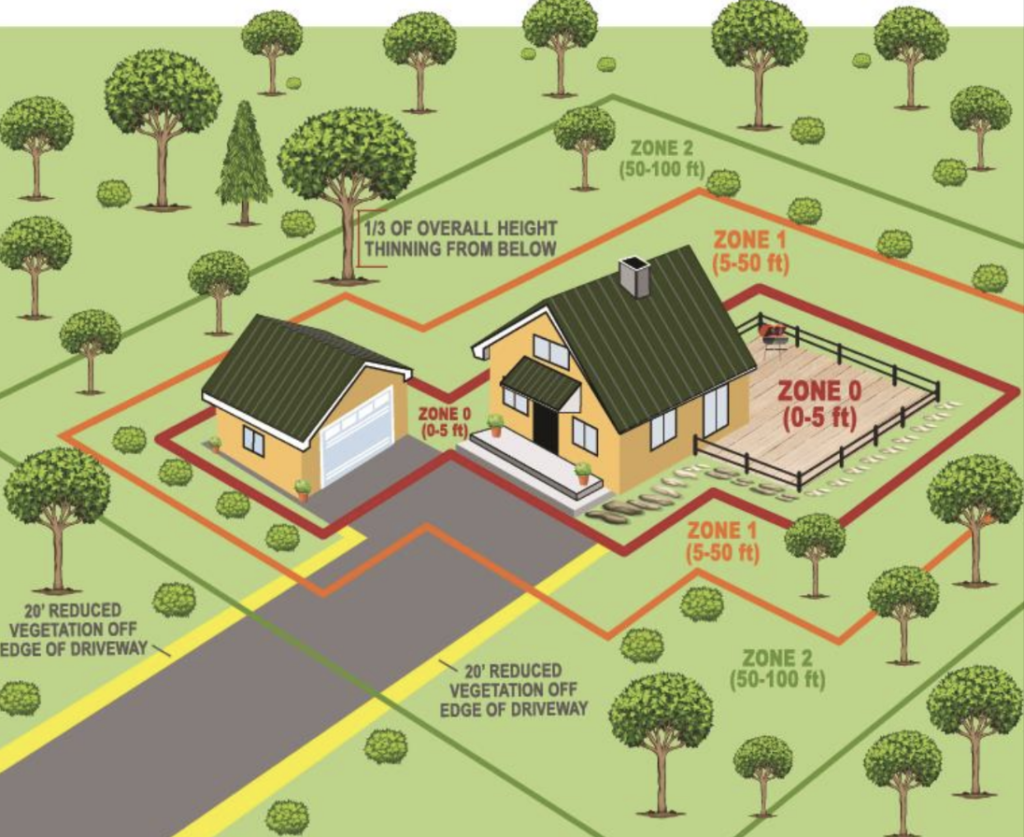Defensible Space Requirements
Zone Zero: is 0 – 5 feet from buildings, structures, decks, etc. This area is Non-Combustible Zone. REMOVE – REDUCE and REPLACE. Functions to reduce the potential that embers landing near a building will ignite fuels and expose the area around a home to a direct flame.
- Use noncombustible materials such as rock, stone pavers, cement, bare earth, gravel or sand.
- Remove leaves, needles, or other dead vegetation growth from all roofs and gutters.
- Clear vegetation and items that could ignite from around and under decks.
- Use of mulch, bark and or compost shall be prohibited.

Zone One: is 5 – 50 feet from buildings, structures, decks, etc. This area requires the greatest reduction of flammable vegetation and consists of low growing fire-resistant plants.
- Vegetation is low growing 6” to a maximum of 18” in height.
- Remove dead vegetation and dead trees, mow, remove weeds, and prune lower limbs.
- Trim tree limbs at least ten feet from chimneys, remove dead branches hanging over buildings and roofs.
- Weeds and annual grasses maintained to a height not to exceed 6 inches.
- Reduce the amount of fuel around the structures by separating the space between fuels, and or reshaping the
retained fuels by trimming. - Replace flammable vegetation with low growing less combustible plants.
Zone Two: is 50 to 100 feet from buildings, structures, decks, etc.
- When tree is over 18 feet in height remove lower limbs to create SIX feet of vertical Clearance above ground.
- When tree is less than 18 feet in height – remove lowest limbs that are 1/3 of tree height.
- Plants/shrubs shall be limbed up off ground, so the lowest branches are 1/3 height of plant/shrub.
- Create ten-foot separation between tree canopies and remove dead limbs.
- Reduce the natural vegetation by 50% of the square footage within this area.
- Weeds and annual grasses maintained to a height not to exceed 4 inches.
- Remove all dead and dying vegetation.

- Stack firewood at least 30 feet away from structures and ten feet off of property line.
- Maintain a 13-foot 6-inch vertical clearance over all roads and driveways for emergency vehicle access.
- Remove vegetation to create bare soil within ten feet of ground mounted solar panels.
- Remove vegetation to create bare soil within ten feet of propane tanks.
- Remove refuse, trash, cuttings.
- Lift/remove limbs from bottom 1/3 of trees.
- Remove all hazardous/combustible vegetation within 20 feet along both sides of driveways and roadways that bound the property.
- In all cases, fuel reduction means arranging the trees, shrubs and other fuel sources in a way that makes it difficult for fire to transfer from one fuel source to another. It does not mean cutting down all trees and shrubs on the property.
Defensible Space Inspection for Home Sales
A defensible space inspection is required for all homes that are sold and located within a “high” or “very high fire severity” zone in the State of California in accordance with Assembly Bill No. 38. The inspection will determine if the property being sold is in compliance with all local ordinances.
The Lakeside Fire Protection District has enacted a defensible space ordinance, which can be found in the County of San Diego Consolidated Fire Code. All home sales that occur within the Lakeside Fire Protection District are the primary responsibility of the District and a request for inspection can be made through an online public portal.
Interested in learning more about defensible space?
Not only is having a defensible space required by law, but it plays a vital role in the protection of your family and home. You can learn more about defensible space by visiting San Diego County Fire Authority and Fire Safe Council of San Diego County. You can also download a defensible space flyer and a vegetation clearing FAQ sheet by clicking the buttons below.